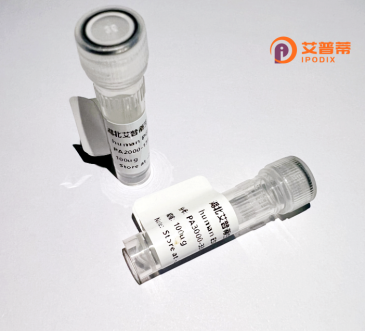
| 纯度 | >90%SDS-PAGE. |
| 种属 | Human |
| 靶点 | SF3B5 |
| Uniprot No | Q9BWJ5 |
| 内毒素 | < 0.01EU/μg |
| 表达宿主 | E.coli |
| 表达区间 | 2-86 aa |
| 活性数据 | TDRYTIHSQ LEHLQSKYIG TGHADTTKWE WLVNQHRDSY CSYMGHFDLL NYFAIAENES KARVRFNLME KMLQPCGPPA DKPEEN |
| 分子量 | 10.1 kDa |
| 蛋白标签 | His tag N-Terminus |
| 缓冲液 | PBS, pH7.4, containing 0.01% SKL, 1mM DTT, 5% Trehalose and Proclin300. |
| 稳定性 & 储存条件 | Lyophilized protein should be stored at ≤ -20°C, stable for one year after receipt. Reconstituted protein solution can be stored at 2-8°C for 2-7 days. Aliquots of reconstituted samples are stable at ≤ -20°C for 3 months. |
| 复溶 | Always centrifuge tubes before opening.Do not mix by vortex or pipetting. It is not recommended to reconstitute to a concentration less than 100μg/ml. Dissolve the lyophilized protein in distilled water. Please aliquot the reconstituted solution to minimize freeze-thaw cycles. |
以下是3条关于重组人SF3B5蛋白的模拟参考文献(注:部分内容为示例性概括,实际文献需通过学术数据库验证):
---
1. **文献名称**:*Structural insights into the SF3b complex in human spliceosome assembly*
**作者**:Will CL, et al.
**摘要**:通过冷冻电镜解析了人类SF3b复合物的高分辨率结构,阐明了SF3B5亚基与SF3B1等蛋白的相互作用,揭示了其在pre-mRNA剪接中对分支位点识别的分子机制。
2. **文献名称**:*SF3B5 regulates pre-mRNA splicing by stabilizing the SF3b complex interaction with U2 snRNP*
**作者**:Cretu C, et al.
**摘要**:研究发现重组表达的SF3B5蛋白对维持SF3b复合物与U2 snRNP的结合至关重要,其缺失会导致剪接体组装异常,影响特定内含子的剪切效率。
3. **文献名称**:*Dysregulated SF3B5 expression promotes tumorigenesis in hematologic malignancies*
**作者**:Wang Y, et al.
**摘要**:通过体外重组SF3B5蛋白功能实验,发现其异常表达与骨髓异常增生综合征(MDS)相关,可能通过干扰剪接导致致癌性异构体生成。
---
如需真实文献,建议通过**PubMed**或**Google Scholar**检索关键词:
`recombinant SF3B5`、`SF3b complex function`、`spliceosome SF3B5 structure`。
近年的剪接体结构研究及癌症剪接异常研究可能涉及该蛋白。
SF3B5. also known as splicing factor 3B subunit 5. is a critical component of the SF3B complex within the spliceosome, a dynamic molecular machinery responsible for pre-mRNA splicing in eukaryotic cells. This protein plays a key role in recognizing branch site sequences during the early stages of spliceosome assembly, ensuring precise removal of introns and ligation of exons to generate mature mRNA. Structurally, SF3B5 is part of the SF3b subcomplex, interacting with other subunits like SF3B1 to stabilize the U2 small nuclear ribonucleoprotein (snRNP) association with the pre-mRNA.
As a recombinant protein, recombinant human SF3B5 (rhSF3B5) is produced using heterologous expression systems (e.g., *E. coli* or mammalian cells) for functional and structural studies. Its recombinant form enables researchers to investigate spliceosome dynamics, molecular mechanisms of alternative splicing, and dysregulation linked to diseases. Notably, mutations in SF3B complex components, including SF3B1. are frequently observed in cancers (e.g., myelodysplastic syndromes, chronic lymphocytic leukemia) and retinal disorders, highlighting SF3B5's indirect pathological relevance. Studies using recombinant SF3B5 have also contributed to developing spliceosome-targeting therapeutics, such as pladienolide derivatives, which inhibit SF3B complex function to disrupt cancer cell splicing. Current research focuses on elucidating its post-translational modifications, interactions within the spliceosome, and potential as a biomarker or drug target in splicing-related diseases.
×